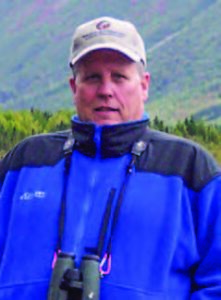21-23 April 2023
Unless otherwise noted, all activities for the AOS Spring Meeting begin or occur at the Dauphin Island Sea Lab (address below):
Shelby Center, Dauphin Island Sea Lab,
101 Bienville Boulevard,
Dauphin Island, AL 36528
To register online for the AOS Spring 2023 Meeting, CLICK HERE
SCHEDULE
FRIDAY, APRIL 21
6:15 a.m. Field Trip:
FIELD TRIP: Baldwin County Birds and Blooms.
Trip Leader: Drew Haffenden
Meeting Time: 6:15 a.m. for a departure at 6:30 a.m. sharp.
Meeting Place: Shelby Center
We’ll start by heading north to Splinter Hill Bog, about 1 1/4 hours from DI up I-65. This bog is one of the largest White-topped Pitcher Plant bogs in America, with four other pitcher plant species also present as well as species of sundews and bladderworts. Our main birding goal, Bachman’s Sparrow, should be singing from exposed perches. Other birds include woodpeckers, Brown-headed Nuthatch, possibly Grasshopper Sparrow, and other species typical of Longleaf Pine habitat. If there has been recent rain parts of the track may be muddy. We return to the coast and Meaher State Park to observe birds from the boardwalk in the shallows of Mobile Bay. The park can hold a variety of birds including shorebirds, herons and egrets, gallinules, Boat-tailed Grackle, Gull-billed Terns and occasionally Anhinga and Roseate Spoonbill. Alligators are also regular here. Continuing along the Mobile Causeway, our next stop, around 11:45–noon, is a seafood restaurant on the Causeway, where we have views overlooking the Mobile-Tensaw Delta while eating some of the best seafood in Alabama.
5:15 p.m. Registration/Social hour at Shelby Center, Dauphin Island Sea Lab
6:00 p.m. Member Social—Shrimp boil and sides (Monetary contributions are welcome)
6:45 p.m. Announcements/Discussion of Weekend Field Trips
7:00 p.m. Members Photography Show
SATURDAY, APRIL 22
6:30 a.m. Field Trips:
FIELD TRIP 1: Exploring Dauphin Island.
Trip Leaders: Dwight Cooley and Barry Fleming
Meeting Time: 6:30 a.m.
Meeting Place: Shelby Center
We’ll bird the varied habitats of Dauphin Island with our Keynote Speaker starting at the airport for rails and sparrows, then to the Shell Mounds for warblers, vireos, tanagers and any other Neotropical migrants we can find. In addition to the Shell Mounds we’ll check out the Audubon Sanctuary and other island hotspots, aided by the cellphone network of sightings by other birders on the island. Other than Audubon Sanctuary, which is a circuit of one mile, there is not a lot of distance walked on this outing, though almost all of our time is spent on foot.
NOTE: It is important for all participants to meet at the Shelby Center, and not arrive at the airport independently. Early airport arrivers can cause rails and sparrows to retreat into the marsh before the rest of the group arrives.
FIELD TRIP 2: Birds of Pelican Bay Peninsula.
Trip Leader: Drew Haffenden
Meeting Time: 6:30 a.m.
Meeting Place: Start of pier in the parking lot at Public Beach (next to school)
Join DI resident Drew Haffenden to get to know the birds of Alabama’s richest beach habitat, Pelican Island, formerly an island, but now a peninsula. With an eBird count currently standing at 186 species, Pelican Island is exceptional for a strip of beach and dune 100-150 yards wide and just over 1.5 miles long at low tide. We’ll take the opportunity to turn the walk into an easy mini-workshop, quickly learning to separate the small plovers from the small sandpipers and from each other, separating often confusing species such as Caspian and Royal Tern, and learning many ID points rarely seen in the guide books. It’s an easy walk on flat sand, and our distance traveled depends on how close the birds are to the pier. The island is growing longer once again, and given the tide, the far end, which often has most of the birds, will be about 1 to 1.3 miles from the pier. Participants can return to their cars at any time. There’ll be several spotting scopes for general use, which can quickly ramp up your shorebird ID skills.
11:30 a.m. Potluck—Lunch at the home of Jennie Stowers. Jennie will provide all food.
5:15 p.m. Registration at Shelby Center, Dauphin Island Sea Lab
5:30 p.m. Banquet and Keynote Speaker: Shelby Center at Dauphin Island Sea Lab
5:30 p.m. Social Hour
6:30 p.m. Banquet Buffet
7:15 p.m. Announcements and Discussion of Field Trips
7:30 p.m. Keynote Speaker: Dwight Cooley
SUNDAY, APRIL 23
6:30 a.m. Field Trip (BE ADVISED: this will proceed if scouting indicates good birding… see note below)
FIELD TRIP: Blakely Island Ponds.
Trip Leader: Larry Gardella
Meeting Time: 6:30 a.m. for a departure at 6:45 a.m. sharp.
Meeting Place: Shelby Center
*** Parking is very limited at the Mudlakes so some car-pooling is necessary. Participants staying overnight off the island can meet at the Mudlakes. Please advise when signing up, and you will receive directions and start time ***
The Blakeley Island Mud Lakes are a complex of disposal ponds that attract large numbers of shorebirds and waterfowl. We’ll carpool to the site and walk the dirt road up and along the dikes to view rows of ponds of varying depths. Expected birds are American Avocet, Black-necked Stilt, Stilt Sandpiper, and a variety of other shorebirds, as well as Gull-billed Tern, Black-bellied Whistling-Duck, and raptors, often including Peregrine Falcon, Merlin, Mississippi Kite and Northern Harrier, are often seen. We’ll return to Dauphin Island in time for compilation at noon. Walking distance is about two miles in the open with no shade. Terrain is good, level dirt road. Mosquitoes and biting flies may be present. If there has been recent rain places may be muddy. Once on the site participants must stay on theroads, not even going into the immediate vegetated verges. AOS and individuals could lose the hard-won permission to bird here if this occurs.
NOTE 1: This trip is planned, but for the last couple of years bird activity has been very quiet at this usually very productive site. The site will be visited just a little before the trip, and if similarly quiet a different outing may replace this one.the immediate vegetated verges. AOS and individuals could lose the hard-won permission to bird here if this occurs.
NOTE 2: A permit form must be lodged with the State Docks Authority prior to your arrival and the permit displayed inside the windscreen. Go to http://www.aosbirds.org/alabama-birding/blakeley-island/ to register in advance. Registration is valid for the rest of the calendar year.
12:00 p.m. Noon Compilation at Goat Trees (Includes all bird sightings in Mobile and Baldwin Counties from Friday, April 21 to noon, April 23, 2023)
ACCOMMODATIONS AND INFORMATION
Accommodations on Dauphin island are limited, so be sure to make reservations early for AOS Meetings.
Websites:
www.gulfinfo.com
www.townofdauphinisland.org/where-to-stay
Motels:
Gulf Breeze Motel: 251-861-7344 or 1-800-286-0296
Bed and Breakfast:
Dauphin Island Harbor House: 251-861-2119
Air BnB has lots of rentals! www.airbnb.com
Rentals:
Boardwalk Realty, Inc.: 877-861-3992
Tyson Real Estate: 800-865-8312
ACP Real Estate, Inc.: 866-861-3311
Camping:
Dauphin Island Park and Beach Board: 251-861-2742
(fully equipped for both camper and tent camping)
MEET THE KEYNOTE SPEAKER — DWIGHT COOLEY
“A Grand Experiment—Approaching a Century of Bird Conservation at Wheeler National Wildlife Refuge”
Folks in the then sleepy cities of Decatur, Athens and Huntsville and all of north Alabama were going about their lives on July 7, 1938, confident that the Great Depression was winding down. Franklin D. Roosevelt had been elected President in 1933 and had almost immediately initiated his New Deal programs to bring the country out of the depression. The day was probably like most…hot and humid. Far away in our nation’s capital, President Roosevelt was signing Executive Order 7926 establishing Wheeler National Wildlife Refuge on what would become 35,000 acres. The land had been acquired by the Tennessee Valley Authority, one of the President’s New Deal programs, as part of an effort to tame the Tennessee River with a series of dams and bring hydroelectric power, navigation, and recreation to the area. From the outset, Wheeler was to be a bold experiment. It was the first national wildlife refuge established on a multipurpose reservoir in the United States, the first refuge to establish a farming program to provide food for wildlife and a joint venture with TVA, who owned the property and continues to own the majority of refuge lands. Many thought the experiment would be a failure…wildlife conservation could not possibly compete with navigation and operation of the dams. Management of the refuge would turn out to be a challenge. Funding for staff, facilities and equipment for management would be scarce initially and remains a challenge today. Almost immediately after establishment, waterfowl started using wetlands on the new refuge. The burgeoning farming program was providing more and more food for waterbirds and other species and by the early 1960s upwards of 60,000 geese, 75,000 ducks and untold numbers of other migratory birds and wildlife were wintering on the refuge. Like most areas managed for wildlife, waterfowl numbers tend to fluctuate due to a number of reasons. However, wintering Canada Goose numbers started a steady decline in 1963 and would fall to below 1,000 by the turn of the century. Fortunately, numbers of other wintering waterfowl remain at historical levels. Because of the variety and number of birds, today Wheeler NWR is one of the most visited refuges in the South. We will take a look at the programs that have contributed to success of the refuge and explore some of the personalities that have been a part of that success.
|
|
Dwight Cooley grew up in rural Limestone County and developed an early interest in birds when he received a pair of binoculars for Christmas when he was eleven. His first sighting through those binoculars was of 20 Cedar Waxwings on Christmas morning. Of course, at the time, he had no idea what species those 20 birds were. ..but he was hooked. He worked for the U.S. Fish and Wildlife Service for 36 years at locations throughout the southeast including Merritt Island NWR in Florida, Mississippi Sandhill Crane NWR in Mississippi, and Alligator River and Pea Island NWR’s on the North Carolina Outer Banks. From 1997 until his retirement in 2016, he served first as Deputy Project Leader and then Project Leader at Wheeler NWR Complex, a group of seven national wildlife refuges spread over 12,500 square miles of northern Alabama. His professional interests revolve around migratory bird management, habitat management and restoration, endangered species management, and connecting people with nature. He holds a BS in biology from Athens State University and an MS in zoology and wildlife from Mississippi State University. He and his wife Deb are both native Alabamians. |

